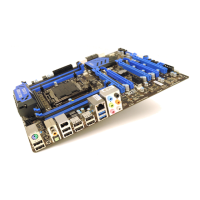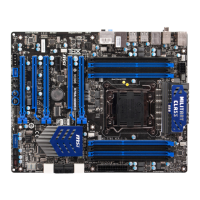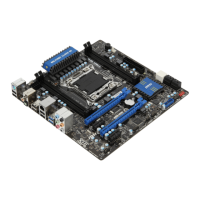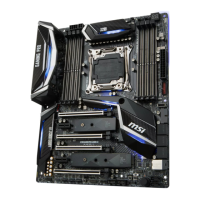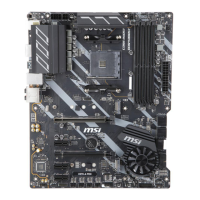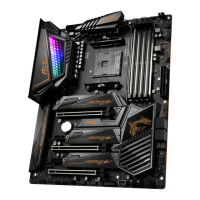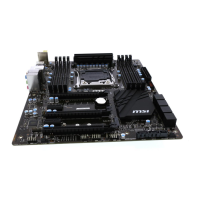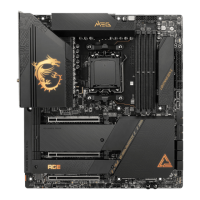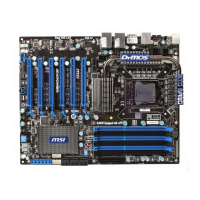Do you have a question about the MSI X79A-GD45 (8D) series and is the answer not in the manual?
Details copyright, trademarks, and manual revision history.
Provides support contacts and essential safety guidelines for users.
Includes FCC interference statements and other regulatory information.
Covers battery, chemical substance, and WEEE disposal guidelines.
Overview of the mainboard, its features, and benefits.
Lists included items and details available optional accessories.
Essential safety guidelines and electrostatic discharge (ESD) protection for installation.
Detailed specs: CPU, chipset, memory, LAN, audio, SATA, RAID, USB, multi-GPU.
Identification of all mainboard connectors, buttons, and switches.
Visual guide to the location and identification of mainboard connectors.
Detailed reference for each port type and its page number.
Visual guide and description of the mainboard's rear panel connectivity ports.
Description of LAN jack and audio port functions and colors.
Info on LGA2011 CPU socket and detailed steps for CPU/cooler installation.
Guide to correctly positioning and securing the mainboard in the case.
Explanation of the ATX 24-pin, 8-pin, and 4-pin power connectors.
Guide to installing DDR3 memory, multi-channel modes, and population rules.
Overview of PCIe slots and their capabilities.
Instructions for installing graphics cards.
Guides for installing and using AMD CrossFireX and NVIDIA SLI.
Details on SATA connectors for storage and fan headers for cooling.
Instructions for connecting front panel headers, USB 2.0, and USB 3.0 ports.
Instructions for connecting front panel audio jacks and optional TPM module.
Details on the high-speed serial communication port.
Information on connecting optional Voice Genie and MultiConnect Panel connectors.
Guide to measuring critical system voltages on the mainboard with a multimeter.
Explanation of OC Genie for auto-overclocking and the system power button.
Configuration options using jumpers for CMOS and BIOS selection via switch.
Description and interpretation of the mainboard's diagnostic LED indicators.
Overview of the CLICK BIOS II UEFI interface and its capabilities.
Instructions on accessing and navigating the CLICK BIOS II interface.
Explanation of keyboard hotkeys and mouse interactions within the BIOS.
Configuration of system date, time, and viewing system status.
Configuration for PCI subsystem, latency, and ACPI power states.
Settings for USB controllers, serial ports, and fan speed control.
Configuration of boot device priority and wake-up event settings.
Options for saving, discarding, restoring defaults, or exiting BIOS.
Introduction to overclocking, CPU/DRAM frequencies, and voltage adjustments.
Detailed voltage controls and management of overclocking profiles.
Information on CPU specs, Hyper-Threading, and virtualization technologies.
Settings for CPU power states, dynamic power technology, and turbo boost.
Configuration options for power saving and motherboard LED control.
Instructions for installing and using the MSI Winki application for internet access.
Guide to using HDD backup and online BIOS Live Update.
Instructions for using M-Flash for BIOS file management and updates.
Detailed steps for updating the BIOS using the Live Update utility.
Configuration of passwords and using USB devices as security keys.
Configuration for Trusted Platform Module and chassis intrusion detection.
Overview of the Realtek audio capabilities and features.
Step-by-step instructions for installing the HD audio driver.
Description of the audio manager's interface and features.
Configuration of audio output devices, volume control, and jack status.
Visual diagrams showing default back panel audio jack connections for 2-channel and 4-channel setups.
Visual diagrams showing default back panel audio jack connections for 6-channel and 8-channel setups.
Overview of configuring SATA hard drives with Intel RAID functionality.
Description of RAID levels (0, 1, 5, 10) and minimum drive requirements.
Instructions for entering the Intel RAID configuration utility during boot.
Step-by-step guide to creating new RAID volumes with different levels.
Procedure for removing existing RAID volumes and their data.
Instructions for converting RAID disks back to standard non-RAID disks.
Guide to installing the Intel RSTe drivers during OS setup.
Steps to verify the correct installation of the Intel RAID controller driver.
Procedures for handling missing or failed hard drive members in a RAID array.
How to check the progress of RAID array rebuilding using the Intel RSTe application.
| Brand | MSI |
|---|---|
| Model | X79A-GD45 (8D) series |
| Category | Motherboard |
| Language | English |



